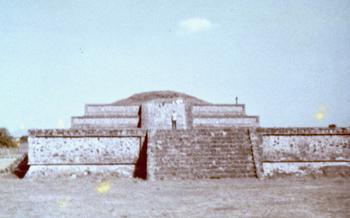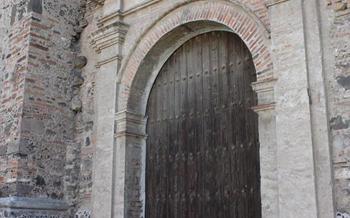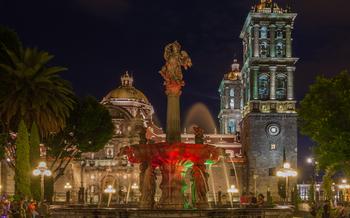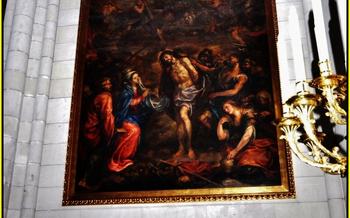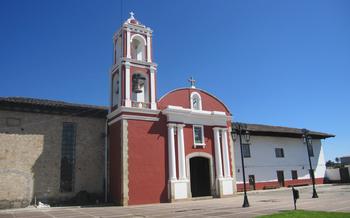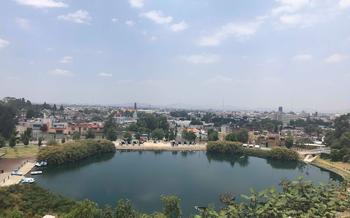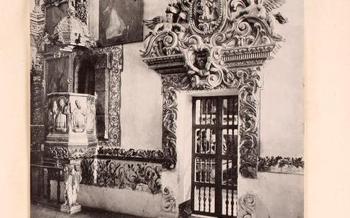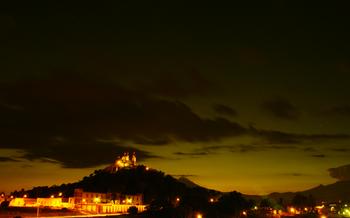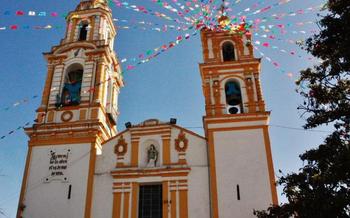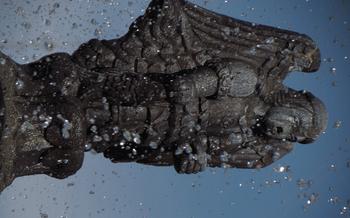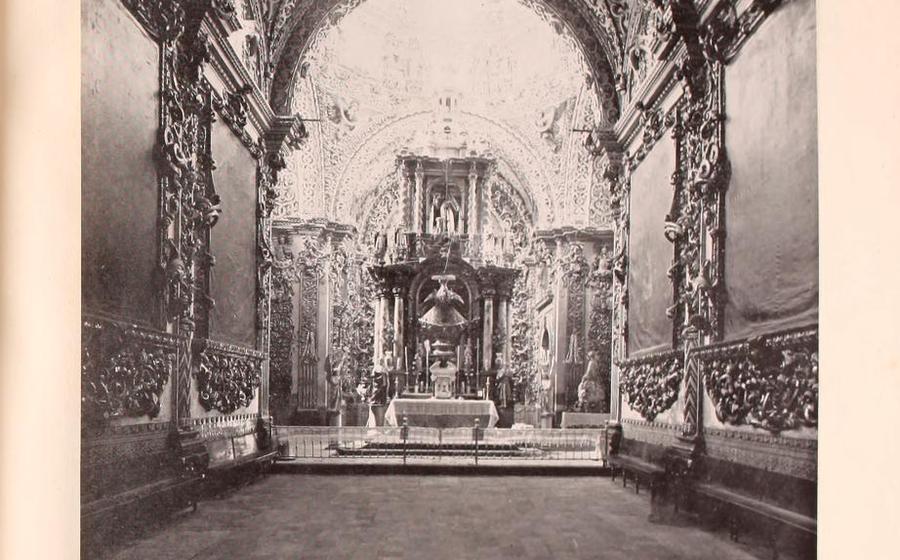
Capilla del Rosario (Rosary Chapel)
- Capilla del Rosario: An Architectural Masterpiece
- Location and Accessibility
- Talavera Tiles and Craftsmanship
- Baroque Interior and Decorations
- Altarpieces and Devotion
- History and Religious Significance
- Guided Tours and Local Guides
- Photography and Capturing the Beauty
- Nearby Attractions and Recommendations
- Events and Celebrations
- Local Artisans and Crafts:
- Insider Tip: Unveiling the Chapel's Hidden Gem
Capilla del Rosario: An Architectural Masterpiece
The Capilla del Rosario a masterpiece of the Mexican Baroque style. Built in the 17th century, the chapel is a testament to the fusion of indigenous and European influences that shaped the architectural landscape of Mexico. Its elaborate facade, adorned with intricate carvings and sculptures, tells a story of devotion, artistry, and the rich history of Puebla.
The chapel's unique design features include its octagonal shape, which symbolizes the eight beatitudes, and its two towers, representing the Dominican order's commitment to education and preaching. The intricate details of the facade, such as the cherubs, angels, and floral motifs, showcase the exceptional craftsmanship and attention to detail that went into its construction.
The Capilla del Rosario stands as a testament to the fusion of indigenous and European influences that characterized the colonial period in Mexico. Its unique architectural features, combined with its rich symbolism and historical significance, make it a must-see attraction for anyone visiting Puebla.
Location and Accessibility
The Capilla del Rosario is conveniently located in the historic center of Puebla, a UNESCO World Heritage site. It is situated on the corner of 16 de Septiembre and 5 de Mayo streets, within easy walking distance of other major attractions such as the Zócalo (main square), the Cathedral, and the Amparo Museum.
To get to the chapel, visitors can take advantage of Puebla's efficient public transportation system. The nearest bus stop is located just a block away, on 18 de Noviembre street, and several bus routes pass through the area. Alternatively, visitors can opt for a leisurely walk through the city's charming colonial streets, enjoying the vibrant atmosphere and admiring the surrounding architecture.
Guided tours are also available for those who prefer a more in-depth exploration of the chapel's history and features. These tours are typically offered in Spanish and English and can be arranged through local tour operators or directly at the chapel.
To ensure a convenient and hassle-free visit, it is advisable to plan ahead and check the chapel's official website or contact the local tourism office for the most up-to-date information on visiting hours, admission fees, and guided tour schedules.
Talavera Tiles and Craftsmanship
The Capilla del Rosario is renowned for its exquisite Talavera tiles that adorn its exterior. Talavera pottery is a type of majolica ceramic that originated in the Spanish city of Talavera de la Reina. It was introduced to Mexico during the colonial period and became a significant art form in Puebla, earning the city the title of "Talavera Capital of the World."
The tiles on the chapel's facade are meticulously handcrafted and glazed, featuring vibrant colors and intricate designs. Each tile is a unique work of art, depicting biblical scenes, floral motifs, and geometric patterns. The tiles are arranged in a harmonious composition, creating a stunning visual spectacle that captivates visitors.
The process of creating Talavera tiles is complex and time-consuming. It involves multiple stages, including clay preparation, molding, glazing, and firing. The artisans start by selecting high-quality clay and shaping it into the desired tile form. After drying, the tiles are meticulously hand-painted with intricate designs using natural oxides and minerals.
The tiles are then glazed with a white tin-based glaze that gives them their characteristic shine and durability. The glazed tiles are fired in a kiln at high temperatures, resulting in the vibrant colors and patterns that make Talavera tiles so distinctive.
In Puebla, visitors can find numerous workshops and studios where local artisans specialize in creating Talavera tiles and ceramics. These workshops offer demonstrations and opportunities for visitors to learn about the traditional crafting process and purchase unique souvenirs and handmade gifts. By supporting local artisans, visitors contribute to preserving this traditional craft and ensuring its legacy for future generations.
Baroque Interior and Decorations
The interior of the Capilla del Rosario is a testament to the opulence and intricacy of Baroque architecture. Every surface is adorned with stunning ceiling frescoes, religious iconography, intricate carvings, sculptures, and altarpieces. The interplay of light and shadow creates a sense of awe and wonder within the chapel's sacred space.
The ceiling is a masterpiece of Baroque painting, featuring vibrant frescoes depicting scenes from the life of Christ and the Virgin Mary. The walls are adorned with intricate carvings and sculptures depicting saints, angels, and biblical scenes. The main altarpiece, a towering masterpiece of carved wood and gilded ornamentation, is a focal point of the chapel's interior.
The side altars are equally impressive, each dedicated to a different saint or religious figure. The altarpieces are adorned with exquisite paintings, sculptures, and decorative elements, creating a sense of devotion and reverence within the chapel.
The interplay of light and shadow within the Capilla del Rosario is a testament to the skill of its architects and designers. The natural light filtering through the stained-glass windows casts a warm glow on the chapel's interior, highlighting the intricate details and textures of its decorations. The flickering flames of candles add an ethereal ambiance, creating a truly unforgettable experience for visitors.
Altarpieces and Devotion
The Capilla del Rosario is a breathtaking showcase of Baroque art and religious devotion. The grand main altarpiece, a masterpiece of woodcarving and gilding, dominates the chapel's interior. Its intricate carvings depict scenes from the life of the Virgin Mary, surrounded by a symphony of angels, saints, and cherubs. The altarpiece is a testament to the skill and artistry of the indigenous craftsmen who created it, blending European techniques with their own cultural traditions.
In addition to the main altarpiece, the chapel features numerous smaller side altars dedicated to various saints and religious figures. Each altar is adorned with intricate carvings, paintings, and sculptures, creating a visual feast for the eyes. These altars serve as focal points for devotion and prayer, where visitors can come to pay their respects and seek divine guidance.
The Capilla del Rosario is a living testament to the deep-rooted faith and religious traditions of the Mexican people. It is a place where history, art, and spirituality converge, creating a sacred space that inspires awe and devotion in all who visit.
History and Religious Significance
The Capilla del Rosario holds profound historical and religious significance as a prominent center of worship within the Dominican order. Established in the 16th century, the chapel played a crucial role in evangelization efforts throughout Mexico. Its construction symbolized the fusion of indigenous and European influences, showcasing the blending of architectural styles and religious beliefs. Throughout the years, the chapel has served as a sacred space for prayer, pilgrimage, and the celebration of religious festivals. The devotion of the local community to the chapel's altarpieces and religious figures continues to shape the spiritual identity of Puebla's Catholic community. Exploring the history of the Capilla del Rosario offers a glimpse into the deep-rooted religious traditions and the enduring impact of Catholicism on Mexican culture.
Guided Tours and Local Guides
The Capilla del Rosario offers guided tours in various languages, providing visitors with an immersive and informative experience. These knowledgeable guides bring the chapel's history, architecture, and religious significance to life, offering insights into the symbolism and cultural context of its artwork and decorations.
Having a guide is especially recommended for those seeking a deeper understanding of the chapel's intricate details and the stories behind its construction and devotion. They can point out hidden symbols, explain the significance of different motifs, and provide historical context that enriches the visitor's experience.
When choosing a guide, it is advisable to look for reputable and licensed tour operators who are well-versed in the chapel's history and can offer accurate and engaging commentary. Their expertise not only enhances the visit but also fosters a greater appreciation for the chapel's cultural and religious importance.
By opting for a guided tour, visitors can gain a comprehensive understanding of the Capilla del Rosario, its architectural marvels, and its role as a spiritual and cultural landmark in Puebla.
Photography and Capturing the Beauty
The Capilla del Rosario is a photographer's paradise, offering endless opportunities to capture the beauty of its architecture, intricate details, and religious iconography. Visitors are welcome to take photographs within the chapel, but it is important to be respectful of the sacred space and other visitors. Flash photography is not permitted, as it can damage the delicate artwork and disturb the atmosphere of reverence.
To capture the best shots, consider using a wide-angle lens to capture the chapel's grand interior or a telephoto lens to zoom in on specific details. Experiment with different angles and lighting conditions to create unique and dramatic compositions. Natural light streaming through the stained-glass windows creates a magical glow, especially in the early morning or late afternoon.
After your visit, share your photographs and experiences on social media, using relevant hashtags and tags to connect with other travelers and art enthusiasts. Your images can help promote the chapel's beauty and encourage others to explore this hidden gem in Puebla.
Nearby Attractions and Recommendations
The Capilla del Rosario is situated within the heart of Puebla's historic center, where visitors can effortlessly explore a wealth of additional attractions. A short stroll away lies the majestic Puebla Cathedral, renowned for its grand architecture and intricate facade. The nearby Zócalo, or main square, bustles with life, offering a vibrant mix of street vendors, cafes, and historical landmarks.
For those seeking a deeper immersion into Puebla's rich culinary traditions, the surrounding streets are lined with authentic restaurants serving mouthwatering local specialties. Sample the delectable flavors of mole poblano, a complex sauce made with over 20 ingredients, or indulge in the city's famous chiles en nogada, a dish of stuffed poblano peppers topped with a creamy walnut sauce and pomegranate seeds.
Art enthusiasts will delight in exploring the numerous galleries and museums showcasing local and international artwork. The Museo Amparo, housed in a beautifully restored colonial mansion, boasts an impressive collection of pre-Hispanic artifacts, colonial paintings, and contemporary art.
History buffs can embark on a day trip to the nearby Cholula, home to the Great Pyramid of Cholula, the largest pyramid in the world by volume. This ancient pyramid, topped with a 16th-century church, offers stunning panoramic views of the surrounding countryside.
Puebla's vibrant cultural heritage is celebrated through various events and festivals held throughout the year. Visitors can witness traditional dance performances, colorful parades, and religious processions that bring the city's streets to life.
By venturing beyond the Capilla del Rosario, travelers can immerse themselves in the diverse cultural experiences that Puebla has to offer, creating a truly memorable and enriching journey.
Events and Celebrations
The Capilla del Rosario is not just a historical monument but also a vibrant center of religious devotion. Throughout the year, the chapel hosts a variety of special events, festivals, and celebrations that showcase the rich cultural heritage of Puebla.
During Holy Week, the chapel becomes the epicenter of religious processions and reenactments of the Passion of Christ. Locals and visitors alike participate in these solemn and moving ceremonies, which culminate in the Good Friday procession, where a life-sized statue of Jesus Christ is carried through the streets of Puebla.
The feast day of Our Lady of the Rosary, celebrated annually on October 7th, is another significant event at the chapel. Devotees gather to pay homage to the Virgin Mary, the patron saint of the chapel, and participate in special masses, processions, and traditional dances.
These events offer visitors a unique opportunity to immerse themselves in the vibrant religious traditions of Puebla and witness the deep devotion of the local community. To make the most of your visit, plan your trip around one of these special celebrations and experience the chapel's spiritual energy firsthand.
Local Artisans and Crafts:
The Capilla del Rosario is not just a testament to the architectural and artistic prowess of its creators; it is also a showcase of the incredible craftsmanship and artistry of Puebla's local artisans. Visitors to the chapel can explore the surrounding streets and neighborhoods to discover workshops and studios where skilled artisans create exquisite Talavera tiles and ceramics, carrying on a tradition that dates back centuries.
These artisans use traditional techniques passed down from generation to generation to create intricate designs and vibrant colors that adorn not only the chapel but also homes, businesses, and public spaces throughout Puebla. Visitors can witness the meticulous process of tile-making, from the initial molding of the clay to the delicate glazing and firing that brings the tiles to life.
Local workshops and studios often offer demonstrations and classes, allowing visitors to learn about the history and techniques of Talavera pottery firsthand. Whether you choose to simply admire the finished products or try your hand at creating your own unique piece, supporting local artisans is a wonderful way to contribute to the preservation of this traditional craft and take home a truly special souvenir from your visit to Puebla.
Insider Tip: Unveiling the Chapel's Hidden Gem
Amidst the awe-inspiring grandeur of the Capilla del Rosario, a hidden gem awaits discovery. Venture beyond the main altar and explore the sacristy, a secluded chamber where the chapel's treasures are carefully preserved. Here, visitors can marvel at a collection of rare artifacts, including intricately embroidered vestments, antique religious relics, and centuries-old manuscripts. The sacristy offers a glimpse into the chapel's rich history and provides a serene sanctuary for contemplation and reflection. As you wander through this hidden chamber, let the whispers of the past guide you, transporting you back to an era of faith and devotion.
